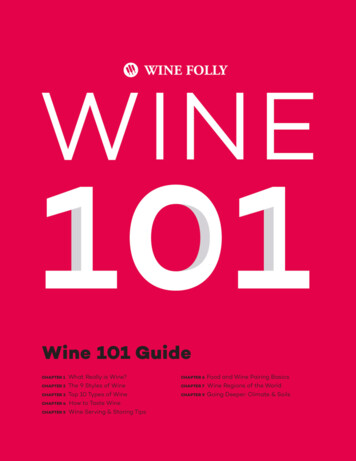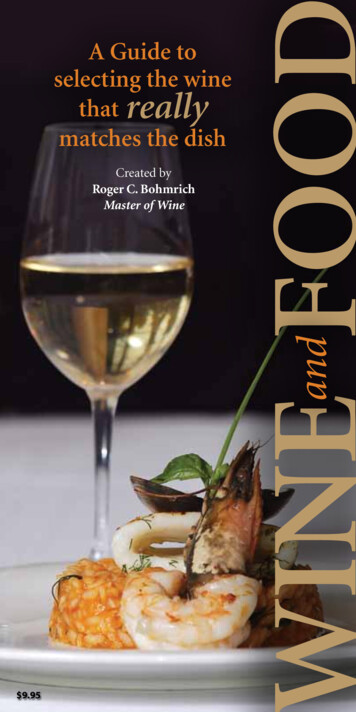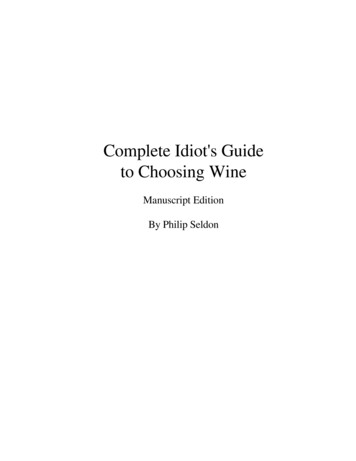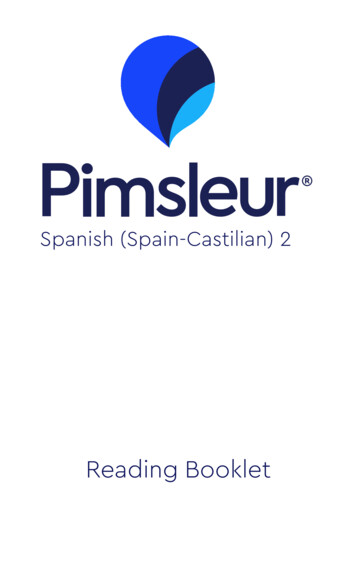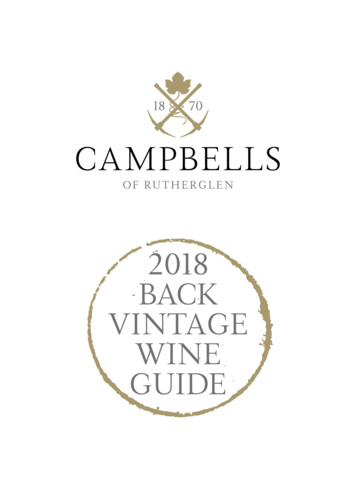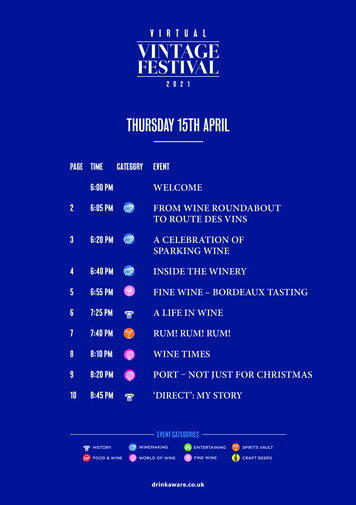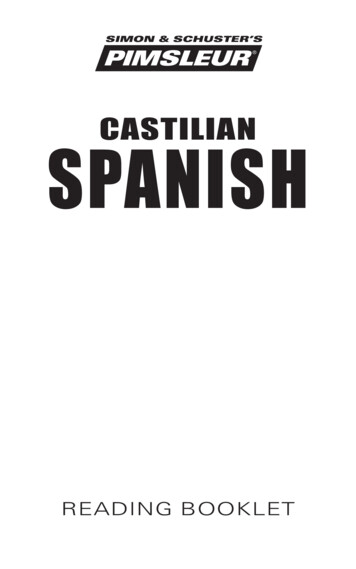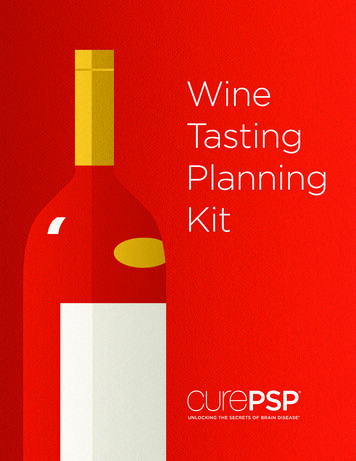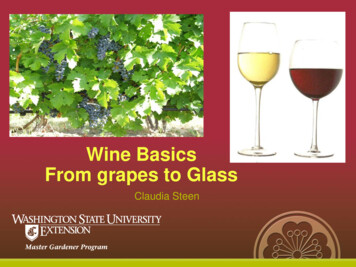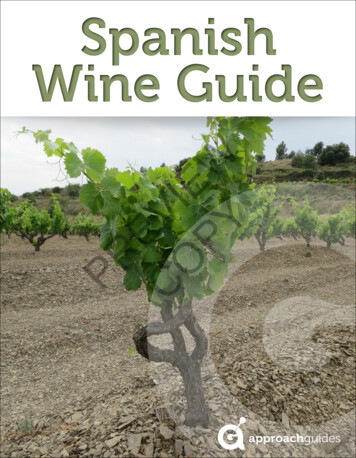
Transcription
PREC VIO EPY W
IntroductionPreviewing this book?Please check out our enhanced preview, which offers a deeper look at this guidebook.Wine guides for the ultra curious, Approach Guides take an in-depth look at a wine region’s grapes,appellations and vintages to help you discover wines that meet your preferences.PREC VIO EPY WWith this guide, we explore perhaps the most dynamic wine-producing country in world, Spain:from the complex garnachas of Priorat, to the enticing vedejos of Rueda, to the enigmatic sherries of Jerez. In addition to being great values, the wines of Spain are exciting, as they are based onmany little-known indigenous varieties. Equally valuable as a travel guide and wine shop companion, this Approach Guide is designed as a quick-reference resource for wine enthusiasts seeking tounderstand what makes Spain’s wines unique and make informed choices.What’s in this guidebook Grape varieties. We describe Spain’s primary red and white grape varieties and where theyreach their highest expressions.Vintage ratings. We offer a straightforward vintage ratings table, which affords high-levelinsight into the best and most challenging years for wine production in Spain.Denomination profiles. We provide detailed profiles of each of Spain’s denominations.For each denomination, this guide describes the prevailing terroir, the types of wine produced and what makes them distinctive.Recommendations. We mark our favorite denominations with asterisks (*) — our selections have a record for providing quality, consistency and good values.Information the way you like it. As with all of our guides, this book is optimized forintuitive, quick navigation; information is organized into bullet points to make absorptioneasy; and links are provided to the best online resources.Contact us anytimeOur readers are our greatest inspiration. Email us at founders@approachguides.com to let us knowabout your experience with Approach Guides — many of our recent updates have been inspired bycustomers like you. We personally respond to every email.We hope you enjoy what we believe is a totally unique guide to the wines of Spain.David and Jennifer Raezer
Founders, Approach Guideswww.approachguides.comWe have also designed this guide as a wine app for the iPhone or iPad (www.agwine.com).Discover Spain with Approach GuidesPREC VIO EPY WCórdoba, the city where Islam got its start in Spain, is home to the 8-10th century Great Mosque,known as the Mezquita. Download our guide to Córdoba’s Mezquita to explore its stunning architecture.Granada, the last stronghold of Islam in Spain, is home to one of Spain’s greatest Islamic sites: the14th century Alhambra. Download our guide to the Alhambra to explore its rich decoration andstunning architecture.
Spanish Wine GuideVersion 2.0by David Raezer and Jennifer Raezer 2015 by Approach GuidesAll rights reserved. No part of this book may be reproduced in any form or by any electronic or mechanical means, without permission in writing from the publisher (excluding Creative Commons images). Further, this book is licensed foryour personal enjoyment only and may not be resold or given away to other people.Copyright, licensing and attribution information can be found in the metadata for all images and illustrations.Approach Guides and the Approach Guides logo are trademarks of Approach Guides LLC. Other marks are the propertyof their respective owners.Although every effort was made to ensure that the information was as accurate as possible, we accept no responsibilityfor any loss, damage, injury or inconvenience sustained by anyone using this guidebook.Approach GuidesNew York, NYwww.approachguides.comISBN: 978-1-936614-45-5
ContentsIntroductionHow to Use This Wine GuideOverviewRed Grape VarietiesWhite Grape VarietiesVintagesRegionsPREC VIO EPY WDenominations and AgingRegional MapRegional Listing of DenominationsDenominationsAbonaAlellaAlicante *Almansa *Arabako TxakolinaArlanzaArribesBierzo *Binissalem *Bizkaiko TxakolinaBullasCalatayudCampo de BorjaCariñena *Cava *
CigalesConca de BarberàCondado de HuelvaCosters del SegreEl HierroEmpordàGetariako Txakolina *Gran CanariaJerez (Sherry) *PREC VIO EPY WJumilla *La GomeraLa PalmaLa ManchaLanzaroteMalaga y a-MorilesMontsant *NavarraPenedèsPla de BagesPla i Llevant de MallorcaPriorat *Rías Baixas *Ribeira Sacra
Ribeiro *Ribera del Duero *Ribera del GuadianaRibera del JúcarRioja AlavesaRioja Alta *Rioja BajaRueda *SomontanoPREC VIO EPY WTacoronte-Acentejo *TarragonaTerra AltaTierra de LeónToro *UclésUtiel-RequenaValdeorras *Valdepeñas *ValenciaValle de GüímarValle de la OrotavaVinos de MadridYcoden-Daute-Isora *YeclaGoing to Córdoba or Granada?About Approach GuidesContactFree Updates and Enhancements
PREC VIO EPY WMore from Approach Guides
How to Use This Wine GuideThis is a very different kind of wine guide. It leverages the strengths of the digital medium to makeunderstanding Spain’s wines easier and more intuitive.What’s Inside A framework. We emphasize the fundamental themes that are key to understanding Spainand its wines.Everything in context. We place the wines of each wine-producing denomination intocontext by comparing them to regional benchmarks and neighboring denominations.Strategy and recommendations. We provide a strategy for choosing wines in eachdenomination, giving particular consideration to those that offer the best values. Our recommended denominations and grape varieties are marked with asterisks (*).PREC VIO EPY W How It’s Organized Highlighted information. The guidebook uses bullet points to organize information andbold text to highlight key points; this makes it easier for you to isolate what is most important.Simplified navigation. We have designed the table of contents so that you can quicklyjump around to find what you are looking for. Further, you do not have to read in linearmanner, start to finish, since we ensure that key points are included in each denominationprofile.Quick search. We encourage you to use the search feature to find exactly what you arelooking for, whether it is a specific grape, a flavor, or a soil type.Author Tip: To see all of the denominations associated with a specific region, use the searchfunction. Simply search “Region: Catalunya” or any other region and the app will filter thebook for you. It’s easy!
— Pages Missing —Download the complete book online at www.approachguides.com
Red Grape VarietiesBobal *Long used as a blending grape to give structure and color, bobal is now being used as the base tocreate interesting reds and rosés. The indigenous thick-skinned, late-ripening bobal prefers Spain’swarm climates. It yields medium-bodied wines with abundant flavors of wild berries, violets andchocolate; they typically have high acidity. Further, due to high anthocyanins in the thick skins,they are dark in color and high in tannins.CaíñoPREC VIO EPY WBobal-based wines are often blended with tempranillo and garnacha to add aromatic complexityand body. Look for them in Valencia’s Utiel-Requena DO and Castilla-La Mancha’s Manchuela andRibera del Júcar DOs.Grown in Galicia, the rare caíño is a similarly thick-skinned variety. It produces dark, highly aromatic wines with medium weight, high acidity and a strong earthy, mineral streak, usually withblack pepper highlights. They are typically made for immediate consumption in a light, fresh unoaked style. Look to the Rías Baixas and Ribeiro DOs for quality production.CalletNative to Mallorca in the Balearic Islands, callet delivers fresh wines with low alcohol, dark color,raspberry fruit, soft tannins and a distinctive spicy, herbal character. To smooth out its otherwiserough edges, it is usually blended with cabernet sauvignon, manto negro, or tempranillo.CariñenaKnown as carignan in France, cariñena (aka mazuelo and samsó) thrives in warm climates, whichare required to bring this late-ripening variety to maturity. It is best known for being a small contributor to the great garnacha-based wines of Catalunya’s Priorat and Montsant DOs; in its supporting role, cariñena adds good acidity, dark coloration and a boost of tannins, coupled with bright,unmistakable blueberry and violet notes. That said, while its traditional role has been as a blendinggrape, it is just starting to be used on its own to make respectable single-varietal wines.Garnacha *Garnacha — known elsewhere as grenache — produces excellent results in Spain. This thin-skinned
grape prefers warm climates and yields big wines with intense flavors of dark fruit (especially blackberries, raspberries and plums), violets, pepper and spice. While tannins and acidity skew to thelow side, alcohol levels tend to be high. For the best that garnacha has to offer, look to Catalunya’s Priorat and Montsant DOs, whereold vines prevail and the terroir is ideally suited to the variety.Aragón is home to high quality versions at extremely attractive prices. With values in mind,seek out old-vine versions in the Cariñena, Calatayud and Campo de Borja DOs.There are also good values made from old vines in Castilla-La Mancha’s Méntrida DO.Finally, if you are looking for a lighter, crisper option, the grape is used throughout Spain to produce dry, full-bodied rosés.PREC VIO EPY WGarnacha TintoreraNot to be confused with highly-regarded garnacha, garnacha tintorera (aka alicante bouschet),interestingly, is one of the few grape varieties that has colored juice; this quality naturally made itattractive for giving color to bulk wines. But times are changing and garnacha tintorera is beginningto be used for single-varietal wines.Castilla-La Mancha’s Almansa DO is the best denomination from which to try the much-malignedgarnacha tintorera. At its best, the grape yields wines of great depth and richness of flavor: pepper,smoke, cranberries, sour cherries, green peppers and minerals, with a nice dose of acidity. Oftengreat values, they need to breathe a little. Give them time to open up and the rewards will be immense.Graciano *Graciano, grown chiefly in the La Rioja region, has historically been used as a blending grape toenhance the color, aromas and acidity of tempranillo-based wines. However, like many other varieties in Spain, the heat-loving, late-ripening graciano is beginning to be cultivated for single-varietalwines and the early results are encouraging.Single-varietal wines are typically dark, full bodied and intensely aromatic. They deliver flavors ofblueberries, dates and dark (sometimes candied) fruit, with good acidity and ample tannins.Hondarribi BeltzaThe País Vasco’s thick-skinned hondarribi beltza is used to make txakoli (pronounced ‘choc-o-lee’)reds. The grape yields mid-weight wines with high acidity, ample fruit and bitter herb notes. Although there are certainly exceptions, wines can lack balance and polish; accordingly, we do notrecommend wines based on this variety overall. That said, hondarribi beltza is used to make tastyrosés.
— Pages Missing —Download the complete book online at www.approachguides.com
White Grape VarietiesAirénAirén is Spain’s (and the world’s) most widely-planted grape in terms of vineyard planted area,due mainly to the unusually low vine density of the high elevation vineyards in Castilla-La Mancha.Faring well in the region’s exceptionally hot and dry summer growing conditions, it is principallycultivated for use in undistinguished bulk wines and as the base for the ubiquitous Brandy de Jerez.AlbarínPREC VIO EPY WHowever, given the proper treatment to minimize oxidation — cold fermentation in stainless steeltanks and machine harvesting at night — the thick-skinned, very late-maturing airén can yield paleyellow wines of a generally pleasing character: carrying just-sufficient acidity, they have mild aromas and light tropical fruit (banana, melon, pineapple), almond and anise flavors.Likely related to the more famous albariño, the rare albarín yields wines with grapefruit, ripe lime,orange, melon and fig flavors; perhaps slightly more aromatic that those based on albariño, theytypically have a herbaceous streak, good minerality and pronounced acidity.The early-ripening grape suffers from overproduction and quality levels are not consistently high.That said, albarín has recently begun to be grown to a high standard of quality for single-varietalwines in Castilla y León’s Tierra de León DO.Albariño *Indigenous to Galicia, the thick-skinned, typically early-ripening albariño is one of Spain’s starwhite varieties. Wines based on albariño have abundant fruit (peaches, apricots), generous mouthfeel and strong saline and floral notes; acidity levels are high, but not so much that they impactthe lingering finish. Although it fares well with barrel fermentation and aging, albariño is typicallyfermented in stainless steel and released immediately to showcase the wine’s bright, clean fruitcharacter.The best albariño-based wines are from Galicia, Spain’s coolest and wettest region; the grape isideally suited to these conditions, as its thick skins protect it from fungal disease that could pose anissue for a more delicate variety. Rías Baixas is albariño’s heartland, but Ribeira Sacra also produces nice versions. While the variety is also grown in Portugal, it takes on a bit more fruit-forward,expressive and acidic character in Galicia.Albariño-based wines are particularly well suited to the local cuisine of Galicia, seafood. Keep inmind, prices on these wines tend toward the higher side, given the low overall production levels andthe grape’s increasingly favorable reception in international markets.
— Pages Missing —Download the complete book online at www.approachguides.com
Denominations and AgingPREC VIO EPY WA Spanish Wine LabelFig. 1. A Spanish wine label.A Spanish wine label provides critical information for understanding what to expect before youopen the bottle. Most important, labels reveal the wine’s vintage, wine name, aging, denominationand producer (green highlights in Fig. 1). The denomination and aging information are a bit morecomplicated and require some explanation.DenominationEven if you know nothing about a wine’s producer, the denomination gives you the first big clue asto what’s in the bottle. Put simply, a denomination identifies the specific geographic locationin which the grapes for a wine were grown. Knowing the denomination in which a wine was produced affords you critical information. Terroir. Features of each location’s physical environment — climate, soil type, altitude andexposure — fundamentally impact the nature of the grapes grown there. In this way, thesefeatures, often referred to collectively as terroir, have a profound impact on the wines pro-
— Pages Missing —Download the complete book online at www.approachguides.com
PREC VIO EPY WRegional Map
— Pages Missing —Download the complete book online at www.approachguides.com
Bierzo *OverviewRegion: Castilla y León.Created in 1989, Bierzo is located in the far northwestern corner of the region, on the border withGalicia’s Valdeorras. Vineyards. Most of the vineyards are located at 500-600 meters in elevation along thesteep slopes of the Sil river and its tributaries.Soils. Soils are alluvial (with traces of iron) along the river’s edge; slate and granite concentrations increase up slope.Climate. The zone is exposed to the sea, which offers it a significantly cooler climate withmore stable intra-day temperatures than other denominations in Castilla y León.PREC VIO EPY W Red Wines *Reds are Bierzo’s focus. Bierzo is Spain’s premier denomination for mencía; this is where we recommend youexperiment with this up-and-coming variety.Bierzo’s climate is marginally warmer than the other mencía-growing denominations inneighboring Galicia (Valdeorras and Ribeira Sacra). This, coupled with the mineral-richsoils, generates a stylistic difference: Bierzo’s versions are the richest, fullest-bodied andmost fruit-forward versions of mencía available.White WinesBierzo has good whites, although they do not yet rival those coming from neighboring Galicia. Tasty godello-based whites are made in a crisp, full-bodied and fruit-forward style.Wines based on dõna blanca are also produced.More Information Official websiteProducers
— Pages Missing —Download the complete book online at www.approachguides.com
Priorat *OverviewRegion: Catalunya.Created in 1954, Priorat — named after the 12th century Carthusian Priorato de Scala Dei, the Prioryof the Stairway of God, under the auspices of which winemaking began in the region — is one of thehighest-esteemed denominations in all of Spain. SoilsVineyards. Vineyards sit at high altitudes, ranging from 100-800 meters, with the best onsteep slopes at the higher end of this range.Climate. The climate is dry and warm. Although the elevation brings cooler evenings, this ismoderated by heat emanating from the soils and the stabilizing influence of the Mediterranean (only 30 kilometers away).PREC VIO EPY W There are two soil types in Priorat, each of which produces a different style of wine: The denomination is famous for its llicorella soils: volcanic in origin, they consist chieflyof slate, with small levels of mica; these soils stress the vines and conserve heat for optimalgrape ripening, producing big wines with bold fruit and intense flavors, with soft, approachable tannins, even when young; they even impart a mineral edge to the resulting wines.Wines from these soils dominate production.At the highest elevations, however, the soils change to red clay; the resulting wines arelighter and more delicate, often with intoxicating aromas.Both soils exist over a schist foundation, which provides a porous enough material for vines topenetrate for stored rainwater reserves and minerals.Red Wines *Red wines are based chiefly on garnacha and cariñena: The primary grape in the blend is low-yielding old-vine garnacha, which accounts fornearly 40% of vineyard planted area. It produces wines with bold, nuanced fruit, laced with adistinctive mineral (slate) edge. The grape’s thin skins impart minimal tannins, so they mustbe introduced by vinifying with stems or aging in small oak barrels (225 liters).The aromatic cariñena brings a blueberry, violet nose and dark color.Although Priorat has gotten a reputation for over-oaking its wines and relying on non-indigenousvarieties to enhance the garnacha base, leading winemakers are increasingly returning tomore traditional styles of winemaking to bring out the best in their prized garnacha: vinifying
in cement tanks; aging in larger barrels; using native yeasts; avoiding destemming; and decreasing the percentage of cabernet sauvignon and syrah in the blend (restoring cariñena to secondaryimportance).Overall, they are special wines; although they can lean toward the pricey side, they are worth it for asplurge.White WinesPREC VIO EPY WAlthough reds are clearly its focus, Priorat does produce a small amount (under 5% of total production) of high quality white wines based on two traditional Catalunyan varieties: garnacha blancaand macabeo.More Information Official websiteProducers
— Pages Missing —Download the complete book online at www.approachguides.com
Spain Reading ListWe’ve re-imagined the travel reading list for those seeking more rewarding and fulfilling experiencesaround the world. Explore our collection of “Trip Reads” — expertly-curated print books, ebooks,magazine articles, papers from leading academics, online resources, music, podcasts, videos andmore.Here are just a few of our Spain recommendations (see the complete list): Late Dinner: Discovering the Food of Spain Of the many books on Spanish cuisines,this is the best for the traveler. By Paul Richardson.“Sharing a Sherry Treasured in Spain” Visiting three bodegas in search of the mysterious, elusive palo cortado. By Geoffrey Gray.The Sounds of Flamenco Listen to a playlist containing a personal collection of Andalucia’s signature music, flamenco, compiled by our founder Jennifer Raezer. The perfect pre-tripsoundtrack.My 1st Spanish Word Book Just for kids! A bilingual word book that presents pictureslabeled in both Spanish and English. By Angela Wilkes.We encourage you visit tripreads.com to get our Trip Reads for Spain and other destinations throughout the world. Enjoy your travels!
PREC VIO EPY WABOUT APPROACH GUIDESTravel guidebooks for the ultra curious Exclusive focus on cultural sites. Currently available for over 60 destinations worldwide,Approach Guides are focused exclusively on providing deep insight into your destination’sbest cultural sites and experiences.Designed for digital. Guidebooks are designed from the ground up for digital, the idealformat for today’s traveler.More interactive and visually oriented. High-resolution images — maps, photos, floorplans, and illustrations — are often marked up with text to ease identification of key architectural and artistic elements.Organized to make touring easy. Featuring bullet points and fast navigation, ApproachGuides make it effortless to absorb key themes and follow the itinerary.Advice for getting the best cultural experience. To help with planning, guidebooks offer logistical advice and provide links to online resources. Plus, we provide our personal tipsfor getting the most from your experience while on location.Free updates. All guidebooks are marked with version numbers; when we update a guidebook, existing customers can easily download the update for free.Contact
Email us at founders@approachguides.com.PraiseCompulsive (and compulsively informed) travelers, the Raezers are the masterminds behindthe downloadable Approach Guides, which are filled with a university course-worth of historyand insights for 62 destinations worldwide. Why we love it. The Raezers share our desire fordeep, well-researched information on the wonders of the world.Travel LeisurePREC VIO EPY WWhat started as one couple’s travel notes aimed at filling in the gaps in guidebooks has becomeApproachGuides.com — a menu of downloadable travel guides that cover cultural and historical topics of interest to thoughtful travelers. What’s hot: Bite-sized travel guides that specialize in topics ranging from . the foods of Italy to one that helps you explore the historical andarchitectural significance of Angkor’s famous temple structures in Cambodia.Los Angeles Times
PREC VIO EPY WJoin Our Email List!Join our email list
PREC VIO EPY WMore from Approach GuidesGuidebooks for the ultra curious, Approach Guides has more than 40 guides to the world’s greatest cultural sites.Italy France Spain Turkey Jordan Israel Morocco India Sri Lanka Myanmar Cambodia Thailand Java Japan Australia New Zealand Guatemala & Honduras Chile Argentina New York City(www.approachguides.com)Your wine shop companion, the Approach Guides Wine app is the definitive guide to the world’s wines.Wine App for iPhone and iPad(wine.approachguides.com)Trip Reads recommends the best sources of information — books, articles, videos, music and web resources — forgetting to know the world’s greatest travel destinations.Travel Reading Lists(www.tripreads.com)
enhance the color, aromas and acidity of tempranillo-based wines. However, like many other variet-ies in Spain, the heat-loving, late-ripening graciano is beginning to be cultivated for single-varietal wines and the early results are encouraging. Single-varietal wines are typically dark, fu
